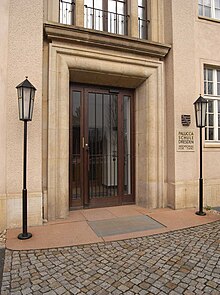
The Elbe Sandstone Mountains, also called the Elbe Sandstone Highlands, are a mountain range straddling the border between the state of Saxony in southeastern Germany and the North Bohemian region of the Czech Republic, with about three-quarters of the area lying on the German side. In both countries, core parts of the mountain range have been declared a national park. The name derives from the sandstone which was carved by erosion. The river Elbe breaks through the mountain range in a steep and narrow valley.

Pirna is a town in Saxony, Germany and capital of the administrative district Sächsische Schweiz-Osterzgebirge. The town's population is over 37,000. Pirna is located near Dresden and is an important district town as well as a Große Kreisstadt.

The exposed geology of the Capitol Reef area presents a record of mostly Mesozoic-aged sedimentation in an area of North America in and around Capitol Reef National Park, on the Colorado Plateau in southeastern Utah.
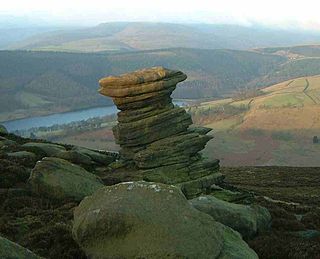
Millstone Grit is the name given to any of a number of coarse-grained sandstones of Carboniferous age which occur in the British Isles. The name derives from its use in earlier times as a source of millstones for use principally in watermills. Geologists refer to the whole suite of rocks that encompass the individual limestone beds and the intervening mudstones as the Millstone Grit Group. The term Millstone Grit Series was formerly used to refer to the rocks now included within the Millstone Grit Group together with the underlying Edale Shale Group.
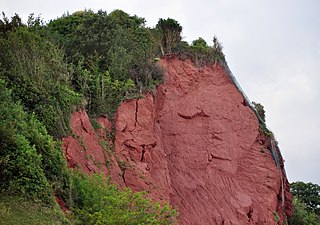
The New Red Sandstone, chiefly in British geology, is composed of beds of red sandstone and associated rocks laid down throughout the Permian to the end of the Triassic, that underlie the Jurassic-Triassic age Penarth Group. The name distinguishes it from the Old Red Sandstone which is largely Devonian in age, and with which it was originally confused due to their similar composition.
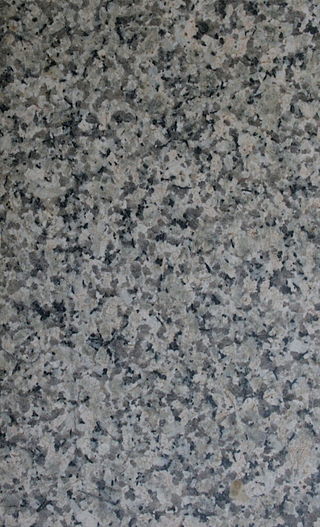
Harz granite is found in the Harz Mountains of central Germany. It may be divided into five types, all of which were widely used as natural stone: Knaupsholz granite, Birkenkopf granite, Wurmberg granite, Königskopf granite and Ilsestein granite. The first three granites were widely used in North Germany, Belgium and the Netherlands and, later, also in East Germany. Knaupsholz granite was "for a long time one of the most important types of cut stone in the former GDR".

The Kulmer Steig is a synonym for the transport links from the Elbe valley over the eastern part of the Eastern Ore Mountains to Bohemian Chlumec u Chabařovic, hence the name which means "Kulm Trail". It is an ancient road system of partly derelict and unmetalled historic transport routes. These historic long-distance routes have been uncovered today thanks to archaeological discoveries. The routes all head south from the Elbe valley between Dresden and Pirna and cross the Eastern Ore Mountains over mountain passes on the Saxon side between Fürstenwalde in the west and Oelsen in the east. The lowest crossings are located near Mohelnice from where they continue via Habartice and the Geiersberg as well as Krasný Les and further on over the Nollendorf Pass to Chlumec. The Kulmer Steig was an especially good transport route because the road cut a passage through untamed wilderness and 30 kilometres could be covered in a day.

Fruchtschiefer is a local variety of contact metamorphic rock that is derived from argillite.

The Cottaer Spitzberg is a 390.8 m high basalt dome on the western edge of Saxon Switzerland. Since 1979 the hill has been a protected area due to its geological and botanical features.

The Tisa Rocks or Tisa Walls are a group of rocks in the Czech Republic. It is located in the western Elbe Sandstone Mountains, not far from its topographical boundary with the Ore Mountains. The region, with its rock pillars up to 30 m high, is one of the major tourist attractions of the region. The Tisa Rocks and the neighbouring Bürschlické Rocks are protected as a nature monument.

Grillenburg Sandstone and Niederschöna Sandstone belong to the Elbe Sandstones of central Europe. There used to be a number of sandstone quarries in the Tharandt Forest and its neighbourhood, not far from Höckendorf and Ruppendorf, near Grillenburg, Niederschöna and Hetzdorf in the state of Saxony. These Cretaceous sandstones emerged in the Cenomanian and Turonian ages. The aforementioned quarries have long since closed.

Elbe Sandstone describes sandstones that naturally occur in North Bohemia and those parts of Saxony within the area around Dresden. It is named after the River Elbe, which cuts through the sandstone region in a transverse valley, the Elbe Valley Zone. It reaches the surface most strikingly in the Elbe Sandstone Mountains, which are divided into the regions of Saxon Switzerland on German soil and Bohemian Switzerland on Czech territory. The term Elbe Sandstone is used in both geological and economic contexts.

Posta Sandstone, also called Wehlen Sandstone, only occurs on the eastern banks of the River Elbe at Alte Poste, near Herrenleithe, Wehlen, Zeichen and Posta. The thickness of the deposit is between 30 and 50 metres. It is also known as Überquader and has the smallest deposit of all the Elbe sandstones. In 2008 it was being quarried in the areas around the village of Lohmen and in Wehlen.
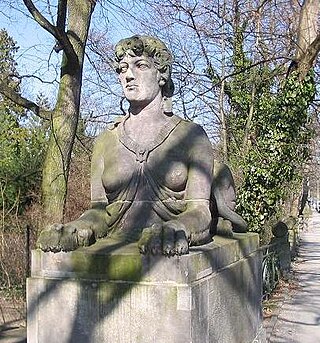
Reinhardtsdorf Sandstone is quarried in the vicinity of Reinhardtsdorf near Pirna in the district of Sächsische Schweiz-Osterzgebirge in the German Free State of Saxony. It is the so-called main sandstone of the Elbe sandstones, and was formed in the Middle Turonian. In 2008 there was one quarry that won this particular sandstone.

Pirna station is the largest railway station in the town of Pirna in the German state of Saxony. The station is integrated into the network of the Dresden S-Bahn. It is also the starting point of a Regionalbahn service and a Regional-Express stop.
The geology of West Sussex in southeast England comprises a succession of sedimentary rocks of Cretaceous age overlain in the south by sediments of Palaeogene age. The sequence of strata from both periods consists of a variety of sandstones, mudstones, siltstones and limestones. These sediments were deposited within the Hampshire and Weald basins. Erosion subsequent to large scale but gentle folding associated with the Alpine Orogeny has resulted in the present outcrop pattern across the county, dominated by the north facing chalk scarp of the South Downs. The bedrock is overlain by a suite of Quaternary deposits of varied origin. Parts of both the bedrock and these superficial deposits have been worked for a variety of minerals for use in construction, industry and agriculture.

Stone crosses in Central Europe are usually bulky Christian monuments, some 80–120 cm (31–47 in) high and 40–60 cm (16–24 in) wide, that were almost always hewn from a single block of stone, usually granite, sandstone, limestone or basalt. They are amongst the oldest open-air monuments. A larger variant of the stone cross, with elements of a wayside shrine is called a shaft cross (Schaftkreuz).

Forbach Granite, also called Raumünzach Granite (Raumünzach-Granit), is a type of granite rock that occurs in the Northern Black Forest. It is part of the Northern Black Forest's granitic massif, to which Bühlertal granite and Wildbad granite also belong. Forbach granite predominantly outcrops in the counties of Calw and Rastatt. The most important quarrying area for Forbach granite used to be the middle Murg valley near Forbach. Today it is only quarried near Raumünzach.

Naxian marble is a large-crystaled white marble which is quarried from the Cycladic Island of Naxos in Greece. It was among the most significant types of marble for ancient Greece and it continues to be quarried in modern times.


